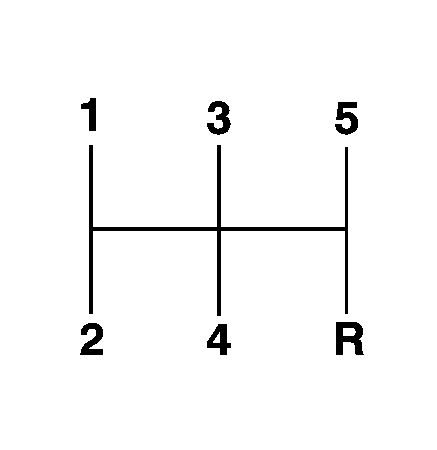Five-Speed

This is your shift pattern. Here's how to operate your transaxle:
FIRST GEAR (1): Press the clutch pedal and shift into FIRST (1). Move the gear selector until you feel a hard stop. Then, slowly let up on the clutch pedal as you press the accelerator pedal. You can shift into FIRST (1) when you are going less than 20 mph (32 km/h). If you have come to a complete stop and it is hard to shift into FIRST (1), put the shift lever in NEUTRAL (N) and let up on the clutch. Press the clutch pedal back down. Then shift into FIRST (1).SECOND GEAR (2): Press the clutch pedal as you let up on the accelerator pedal and shift into SECOND (2). Move the gear selector until a hard stop is felt. Then, slowly let up on the clutch pedal as you press the accelerator pedal.
THIRD (3), FOURTH (4) and FIFTH GEAR (5): Shift into THIRD (3), FOURTH (4) and FIFTH (5), the same way you do for SECOND (2).
To STOP:: Let up on the accelerator pedal and press the brake pedal. Just before the vehicle stops, press the clutch pedal and the brake pedal, and shift to NEUTRAL (N).
NEUTRAL (N): Use this position when you start or idle your engine. The maximum engine RPM is limited in NEUTRAL (N) to 4000 RPM by your vehicle's computer. This is to prevent engine and transmission damage.
REVERSE (R): To back up, press down the clutch pedal and shift into REVERSE (R) from NEUTRAL position. Let up on the clutch pedal slowly while pressing the accelerator pedal. If it is hard to shift into REVERSE (R), put the shift lever in NEUTRAL (N) and let up on the clutch. Then, press down on the clutch pedal again and shift into REVERSE (R).
Notice: Shifting to REVERSE (R) while your vehicle is moving forward could damage the transaxle. The repairs would not be covered by your warranty. Shift to REVERSE (R) only after your vehicle is stopped.
Shift Speeds (Manual Transaxle)
Caution: If you skip a gear when you downshift, you could lose control of the vehicle. You could injure yourself or others. Do not shift down more than one gear at a time when you downshift.
Upshift- Indicator Light (Manual Transaxle Models Only)
Not applicable to vehicles purchased in Canada.

If you have a manual transaxle, you may have a Upshift light. This light will show you when to shift to the next higher gear for the best fuel economy.
When this light comes on, you can shift to the next higher gear if weather, road and traffic conditions permit. For the best fuel economy, accelerate slowly and shift when the light comes on.
While you accelerate, it is normal for the light to go on and off if you quickly change the position of the accelerator. Ignore the Upshift light when you downshift.
Downshifting may be required to keep the engine running smoothly. When you downshift to a lower gear, the light may come on for a moment if the accelerator pedal isn't completely released. Disregard the light during a downshift.
Notice: If you skip more than one gear when you downshift, or if you race the engine when you release the clutch pedal while downshifting, you could damage the engine, clutch, driveshaft, or the transaxle. Do not skip gears or race the engine when downshifting.
